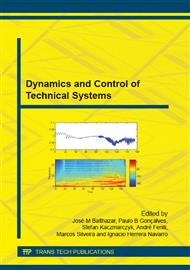[1]
Amira-Elwe, BW500 - Laboratory Setup Ball and Beam, Amira GmbH, (1999).
Google Scholar
[2]
W. Yu, Nonlinear PD regulation for ball and beam system, International Journal of Electrical Engineering Education, vol. 46, issue 1, (2009).
Google Scholar
[3]
J. Hauser, S. Sastry, P. Kokotovic, Nonlinear control via approximate input-output linearization: the ball and beam example, IEEE Transactions in Automatic Control, number 37, vol 3 (1992) 392-398.
DOI: 10.1109/9.119645
Google Scholar
[4]
D. Colón, V. A. Teixeira, I. S. Diniz, Teaching and Comparing Advanced Control Techniques in a Ball and Beam Didactic Plant, Proceedings of the 20th International Congress of Mechanical Engineering, Gramado, Brazil, (2009).
Google Scholar
[5]
L. Ljung, System Identification: Theory for the User, second ed., PTR Prentice Hall Information and System Science Series, PTR Prentice-Hall, Upper Saddle River, N. J, (1999).
DOI: 10.1016/s0026-2692(99)00033-6
Google Scholar
[6]
C. Garcia, Modelagem e Simulação. Editora da Universidade de São Paulo, São Paulo, (1997).
Google Scholar
[7]
J. Craig, Introduction to Robotics: Mechanics and Control, second ed. Addison Wesley Company, (1989).
Google Scholar
[8]
H. Goldstein, Classical Mechanics, Addison-Wesley Publishing Company, (1980).
Google Scholar
[9]
M. A. Bloch, Nonholonomic Mechanics and Control, Interdisciplinary Applied Mathematics, Springer, New York, United States of America, (2003).
Google Scholar
[10]
B. Cazzolato, Derivations of the Dynamics of the Ball and Beam System. Research Report, The University of Adelaide.
Google Scholar
[11]
D. H. Sattinger, O. L. Weaver, Lie Groups and Algebras with Applications to Physics, Geometry and Mechanics. Applied Mathematical Sciences, Springer-Verlag, (1986).
DOI: 10.1007/978-1-4757-1910-9_2
Google Scholar
[12]
F. Bullo and A. D. Lewis, Geometric Control of Mechanical Systems: Modeling, Analysis, and Design for Simple Mechanical Control Systems. Texts In Applied Mathematics, Springer, (2005).
DOI: 10.1007/978-1-4899-7276-7_4
Google Scholar
[13]
C. T. Chen, Linear System Theory and Design, Third edition, Oxford University Press, New York, United States of America, (1999).
Google Scholar
[14]
D. E. Stewart, Rigid-Body Dynamics with Friction and Impact. SIAM Review. Vol 42, No. 1, (2000) 3-39.
Google Scholar
[15]
J. J. Cruz, Controle Robusto Multivariável, Editora da Universidade de São Paulo, São Paulo, Brazil, (1996).
DOI: 10.33594/000000072
Google Scholar
[16]
J. E. Slotine and W. Li, Applied Nonlinear Control. Prentice Hall, (1991).
Google Scholar
[17]
J. P. Bentley, Principles of Measurements Systems, second ed., Longman Scientific & Technical, New York, (1988).
Google Scholar
[18]
D. MacFarlane, K. Glover, A Loop Shaping Design Procedure Using H Infinity Synthesis. IEEE Transactions on Automatic Control, Vol. 37, No. 6 (1992).
DOI: 10.1109/9.256330
Google Scholar
[19]
K. Ogata, Engenharia de Controle Moderno, fourth ed., Prentice-Hall do Brasil Ltda, Rio de Janeiro, (2005).
Google Scholar
[20]
R. S. Sanchez-Pena, M. Sznaier, Robust Systems: Theory and Applications, John Wiley & Sons, New York, (1998).
Google Scholar
[21]
A. Dontchev, F. Lempio, Difference Methods for Differential Inclusions: A Survey. SIAM Review. Vol 34, No. 2, (2000) 263-294.
DOI: 10.1137/1034050
Google Scholar
[22]
I.S. Diniz, A. F. Schvarcz, Modelagem, Simulação e Controle de um Sistema Barra e Bola Auxiliado por Computador: CAD e CAE. Proceedings of the 18th Congresso Brasileiro de Automática, Bonito, Brazil, (2010).
Google Scholar
[23]
F. Andreev, et al, Matching Control Laws for a Ball and Beam System. Proceedings of th IFAC Workshop on Lagrangian and Hamiltonian Methods for Control. (2000).
Google Scholar
[24]
J. M. Lemos, R. N. Silva, J. D. Marques, Adaptive Control of the Ball and Beam Plant in the Presence of Sensor Measure Outliers. Proceedings of the American Control Conference, Anchorage, AK May 8-10. (2002).
DOI: 10.1109/acc.2002.1025381
Google Scholar
[25]
D. Colón, Y. S. Andrade, A. M. Bueno, I. S. Diniz, J. M. Balthazar, Modeling, Control and Implementation of a Ball and Beam System, Proceedings of the 22nd International Congress of Mechanical Engineering, Ribeirão Preto, Brazil (2013).
Google Scholar
[26]
K. Taubert, Converging Multistep Method for Initial Value Problems Involving Multivalued Maps. Computing, 27 (1981) 123-136.
DOI: 10.1007/bf02243546
Google Scholar
[27]
J. L. Junkins, Y. Kim, Introduction to Dynamics and Control Flexible Structures, AIAA Education Series, USA (1993).
Google Scholar
[28]
M. Nagurka, S. Huang, A Mass-Spring-Damper Model of a Bouncing Ball, International Journal of Engineering Education, 22(2006) 393-401.
Google Scholar
[29]
A. Kastner-Maresch, Implicit Runge-Kutta Methods for Differential Inclusion, Numerical Functional Analysis and Optimization, 11(1990) 937-958.
DOI: 10.1080/01630569108816411
Google Scholar
[30]
M. Koga, N. Tanimura, T. Sato, Numerical Simulation using Runge-Kutta Methid for the System with Uncertain Discontinuous Change, Proceedings of the 41st SICE Annual Conference, Osaka (2002) 2749-2753.
DOI: 10.1109/sice.2002.1195530
Google Scholar
[31]
D. Colón, A. M. Bueno, I. S. Diniz, J. M. Balthazar, Nonlinear Ball and Beam Control System Identification. Proceedings of the 11th International Conference on Vibration Problems, Lisbon, Portugal (2013).
Google Scholar


